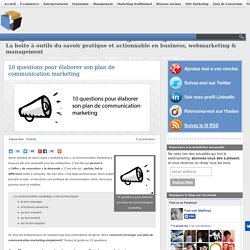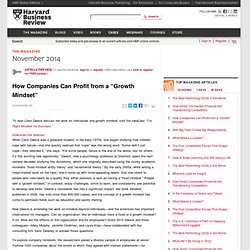

Change Management Watch (CMW) - Veille en gestion du changement (VGC) CEOpedia. Project management tools. Basi Web Marketing. Creare una campagna di Web Marketing. Inside Marketing Rivista - Italia. 10 questions pour élaborer son plan de communication marketing. 10 questions pour élaborer son plan de communication marketing 4ème variable du sacro-saint « marketing mix », la communication marketing a toujours été une nécessité pour les entreprises.

C’est elle qui permet à « l’offre » de rencontrer « la demande ». C’est elle qui , parfois, fait la différence entre 2 marques. Ne rien faire, c’est déjà communiquer. Alors autant prendre la main, et structurer une politique de communication claire, dont vous pourrez avoir la maîtrise. La communication marketing, c’est communiquer:le bon messageà la bonne personneau bon momentau bon endroitsur le bon support Or, tous les entrepreneurs ne naissent pas tous publicitaires de génie. 1 – Dans quel contexte externe & interne dois-je communiquer? Comme toute chose dans le marketing, le travail commence avec une solide analyse SWOT. 2 – Quels objectifs je poursuis: me faire connaître, me faire aimer, faire agir?
La communication ne fait pas « vendre » en soi. B&G - Glossario di Comunicazione. Web Application - Progettazione. Brand e Digital Storytelling. Author Branding/Platform. Brands, SM & conso. Advertising - Totemic Branding. Building A Purposeful Brand. As part of our ongoing work on #ProjectReconnect with the WFA, we recently explored the premise that all brands today must be ‘purposeful’.

They’ve been kind enough to let us share our findings here too. Purposeful Brands In today’s competitive world, a great product is no longer enough for a brand to succeed. A great product is still critical of course; no-one would willingly buy a bad product twice. But as functional performance differences between companies’ offerings become ever more marginal, people increasingly rely on more intangible, emotional factors to inform and guide their choices. As a result, the rules of the marketing ‘beauty pageant’ have changed. Why Your Brand Should Piss Someone Off. The better you are at creating a strong, clear brand position, the more likely you are to find a group of people who really don’t like you.

As Bill Cosby once said, “I don’t know the key to success, but the key to failure is trying to please everybody.” Years ago, the And1 website used to feature an extreme example of this point. Addressing the meaning behind its name, the basketball apparel company announced: “If you don’t know what it means, we don’t want you wearing our shoes.” It’s like life: the only way to have everyone like you is to avoid taking a controversial stance on anything. If you are willing to be anything to anybody--to surrender your identity and your individuality--no one will have strong feelings about you either way. Why Branding Is An Artifact Of The Past.
A short while ago, I wrote an article on this site suggesting that you can’t build a brand simply by setting out to build a brand. And in fact, thinking too much about brands can actually get in the way of the real business of your company. If You Love Your Brand, Set It Free. Advertisement The practice of branding is undergoing a deep transformation — a change brought about by our kaleidoscopic postmodern culture, the development of communication technology and rapid globalization.

In prior decades, brand managers aimed to establish their products and services primarily by way of consistency and repetition. A brand’s voice and message were to be the same, independent of marketing channel. The goal of the designer was to define identity systems that would ensure compliance and coherence in all of the brand’s manifestations, as codified in brand identity style guides. The Reasons For Brand Consistency. Per cominciare una storia: il crowdfunding. Digital Marketing.
Marketing Online. Social Selling. Content Management. Untitled.
The Advanced Guide to Content Marketing. How to Build a Content Marketing Machine. Content Marketing is hot.

White hot. SEO and digital marketing thought leaders are declaring that Content Marketing is the next big thing. Even Rand is touting its importance. The strategy of Content Marketing makes sense: instead of pushing messages about your product at prospects, pull prospects towards you by publishing content about your prospects’ interests. Search rank, traffic, leads and all sort of goodness flow from this approach. So the conversation is no longer about if or why an organization should practice Content Marketing. Le nuove regole del marketing. Qualcosa sta cambiando: Marketing Tradizionale vs. Content Marketing. 11 Skills That Will Make You Successful In A Content Marketing Career. “What are you ever going to do with that?”

That’s the usual response I’d get when people would ask what my college degree was in (it was art and art history). There would be a prolonged moment of silence and then that question. I don’t know if that prolonged moment of silence was in honor of the memory of what they thought was now-gone employability. I can promise you that as I got older and there was more distance from my college graduation, I fretted less. Because in the ensuing years, I learned that the answer to that question was: quite a lot. Persuasion, influence. 3 bias cognitivi usati dagli esperti per creare contenuti persuasivi. How to Manipulate People For Fun (and Profit) When you’re building a website, the secret to building a large audience of readers and customers fast is all about “pulling triggers.” Emotional “hot” triggers.
And while some people call this manipulation, the truth is that it’s just smart marketing. The Three Habits of Highly Effective Demotivators. Jake, a young marketing whiz, thought he’d found his perfect match in a well-funded technology startup in the academic sector.

(It’s a real company, but I’ve changed all names.) For the first few months, Jake was in heaven: smart colleagues, plenty of autonomy, an open field of savvy customers looking for solutions in a hot sector, behind-the-curve competitors, and a terrific product he could sell with his heart. The only problem was Lawrence, the startup’s CEO. Lawrence was brilliant, no doubt about it, and great when it came to dazzling the venture crowd.
He’d step into a roomful of funders, deliver the gospel as he saw it, paint a thrilling picture of the company’s future, and walk away with bulging pockets. But among his super-talented employees, most of whom had joined the company because they felt inspired by the service the company offered, Lawrence was known mostly as the “DM.” 49 Ways to Gain the Trust and Loyalty of Your Audience. Who influences you? And who do you influence? The rise of "influence." Remember when you looked to TV and newspaper ads to tell you what to buy? Me neither. That's because now many of us are more likely to make an informed opinion about purchases--and many other new discoveries--based on the views of people we connect with online and through social media.
Influence, that is to say, is big. How big? A new survey by Initiative questioned some 8,000 web users age 16-54 in Argentina, Australia, Canada, China, Germany, the Netherlands, U.S., and U.K. to find out how they were influenced in purchase decisions by social media interactions. A different study, by Market Force, underscored the fact that brands are leveraging social media to promote themselves. Appliquer l’analyse stratégique au lobbying. La mia idea di comunicazione. Contagious Communications.
Why the Growth Mindset is the Only Way to Learn. How Companies Can Profit from a “Growth Mindset” To hear Carol Dweck discuss her work on individuals and growth mindset, visit the IdeaCast “The Right Mindset for Success.”

Download this podcast When Carol Dweck was a graduate student, in the early 1970s, she began studying how children cope with failure—and she quickly realized that “cope” was the wrong word. “Some didn’t just cope—they relished it,” she says. “For some people, failure is the end of the world—but for others, it’s this exciting new opportunity.” Dweck, now a psychology professor at Stanford, spent the next several decades studying this dichotomy, which she originally described using the clunky academic monikers “fixed mindset entity theory” and “incremental theory.” Now Dweck is extending her work on mindset beyond individuals—and the extension has important implications for managers. “In broad strokes, we learned that in each company, there was a real consensus about the mindset,” Dweck says.
How a Decision Room Can Enable Change and Innovation. One of the challenges leaders face in times of uncertainty and rapid change is helping senior managers to engage in bigger-picture thinking.

To enable this process, a growing number of companies are creating “decision rooms” – dedicated areas that help them visualize challenges and opportunities from a number of perspectives and make better decisions. David Sibbett, in his new book, Visual Leaders: New Tools for Visioning, Management and Organizational Change, explains why a growing number of organizations are dedicating meeting space to creating visual environments called “decision rooms” that are designed to better support bigger-picture thinking and innovation.
“Much of leadership is focused on guiding people to do things that will produce superior results for the organization,” he explains. “This is a process of maintaining the big picture… and then making astute choices of what to do next. Apprendre en mode BYOD (Bring Your Own Device) : Dossier complet. The Future of Marketing 2016: New Roles, and Trends. 5 Rules For Marketing In The Age Of Discovery. Marketing has entered a new age: Information is no longer programmed into consumers' minds. Since its inception, advertising has been dedicated to the creation of programmed messaging. For nearly 300 years, those who could create the best message and deliver it in a memorable way across as wide an audience as possible won.
In less than a decade, the types of content and ways we consume it have completely changed. Marketers have hardly caught up. Success is much harder to achieve than it was a decade ago. Zero Moment of Truth e content marketing: soddisfa la domanda giusta. The Complete Beginner's Guide to Creating Marketing Personas. Over my career I have been fortunate to work for a number of different organizations, all of which have been in completely different stages of their marketing maturity.

Regardless of what stage they are in, one of my first priorities is creating in-depth marketing personas. Marketing personas are like the foundation for building your marketing house. Without personas, how do you know which message will appeal to your target market’s needs? Or where to reach your audience to build awareness and drive them to your website?
MarketCulture Blog - Using a Customer Culture for Competitive Advantage. A product centric organization is one that is focused on the products it brings to market rather than the customers that buy those products. It looks to develop new products by leveraging technology or specialized skills that exist in the company. It starts by looking internally at its capabilities rather than externally at what needs are not being met. The chart below is a simple comparison of the two approaches: In large complex organizations a product focus provides management with direct line of site into which products are selling well, at what profit and clear product owner accountability. MarketCulture Blog - Using a Customer Culture for Competitive Advantage. The world of business has rapidly transformed over the past 15 years.
From a world where businesses controlled supply, controlled the message and could dictate terms to customers to one where customers have a much louder and more influential voice. While we have always been advocates of businesses that act in the best interests of their customers, it seems market forces are now compelling all businesses to behave this way. So why do we believe 2015 is the year for Customer Centricity? 3 reasons. 1. Here's how 'irrational' customers help your brand. 5 cose che non vi hanno detto sul video per Adidas. L'innovazione va raccontata altrimenti non esiste. Melegatti può essere salvata mentre distrugge il suo brand? Tips and Techniques. Tools. 5 patterns behind successful billion-dollar consumer Web companies. Effectuation: Comment les entrepreneurs pensent et agissent… vraiment. Le cycle du changement de Hudson.
Drawing out the different voices within the three horizon methodology for Innovation. Boids. Innovation and Narrative. Principes clés pour mettre en oeuvre une coopération stigmergique. Why Do Good Ideas Fail? This Diagram Explains. The Mini Business Plan — Nora Conrad. Purple Goldfish Project. QUICKSUMO "The Entrepreneur's Newsletter" The Wisdom of Not Understanding. How to Manufacture Desire: An Intro to the Desire Engine. Putting people first - Towards social business design. Social Media. Social Media Stratagies. Strategy. Using Social Media. The Social Media Road Map. Social Media Italia. Faites la peau à 20 mythes des médias sociaux - Le Blog Kinoa. Social Media Tools List: +100 Social Media Tools. Social Media Tools 101 (From Blogs to Wikis) Easily manage all your social network settings.
Product vs Project Manager. Community management. Community management : comment bien gérer sa communauté ? - Le Blog Kinoa. CMBJ. 5 Community Types Brands Must Choose From. 4 Steps to a Social Media Strategy. 26 Tips for Managing a Social Media Community. Je suis Community Manager - Community Management, lifestyle. 12 basic PR mistakes to avoid. How to Argue for Social Media. 4 Steps for Successful Social Media Training. La règle des 3 I sur les réseaux sociaux. From Social Media To Social Business Design. Social Media Campaign Management: Spredfast. 6 Ways to Acquire New Customers via Social Media. Step-by-Step Guide to your Social Media Success.
Ouvrir et gérer vos comptes sur les réseaux sociaux. Social Fresh - The Business of Social Media. Crisis Communications. Qu’est-ce que le Perception Management ? Virtual Communities, Social Media & Virtual Worlds.